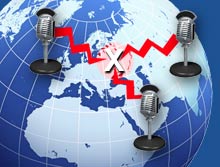Phone Call ‘Line Noise’ Could Expose Thieves
Just as people’s voices betray hints of the region they originate from, so, it turns out, do phone calls. Handsets, telephone exchanges, and other call-routing infrastructure imprint subtle and almost unique fingerprints onto the audio of any phone call, a phenomenon that security company Pindrop hopes to use to prevent fraudsters from using stolen credit cards over the phone.

“We can identify whether a person is using a landline or cell phone, or when a call supposed to come from a mobile in Atlanta comes from a landline in Nigeria,” says Vijay Balasubramaniyan, CEO and cofounder of Pindrop. The “secret” answers and words used to protect bank and other accounts are often easily compromised, particularly using data gleaned online, or through tactics like phishing. Spoofing a caller ID to match a victim’s number when calling their bank has also become commonplace, says Balasubramaniyan.
Pindrop is a relatively young startup, but it is already working with several top banks, says Balasubramaniyan. It processes the recordings of customer calls to flag possible cases of fraud. Another version of the system, not yet released, can instantly communicate a “risk score” when a call connects. That could mean that you don’t get asked so many security questions when you call your bank, because your line noise vouches that it really is you.
You’ve probably noticed that calls placed from different places, different devices, and via different networks, such as a cell phone call compared to one made through Internet services like Skype, sound different. When a person makes a call, the chain of technologies between them and the recipient creates a very particular “line noise.”
Pindrop’s software has been trained to extract specific information from the line noise on a call. It can even estimate a caller’s location, thanks to the patchwork of different telecommunications equipment that links up the globe. “The telephone network has been around for a long time, so there are very different fingerprints for different regions,” says Mustaque Ahamad, a professor at Georgia Institute of Technology and chief scientist and cofounder of Pindrop.
The older infrastructure in Western Europe, for example, makes line noise on calls from there very distinct from those made from Africa. The audio processing software used by providers in different locations also imparts distinctive effects. As a result, a distance of less than 100 miles can alter line noise in a clearly detectable way, says Ahamad, although Pindrop’s service can locate calls only to broad regions.
Ahamad and Balasubramaniyan say that it would be very difficult for a fraudster to spoof line noise. Changing phones—for example, between different wired and wireless handsets—would alter only some of the features that Pindrop looks for, says Ahamad, but “the other features stay the same.”
The only way someone could change his line-noise profile significantly would be to somehow convince the companies carrying the phone calls to replace their current equipment. Even then the line noise would be very unlikely to exactly match that of the person being impersonated. That makes Pindrop’s large and growing database of line-noise fingerprints from known fraudsters a powerful resource to use to screen future calls, says Ahamad.
Keep Reading
Most Popular
Large language models can do jaw-dropping things. But nobody knows exactly why.
And that's a problem. Figuring it out is one of the biggest scientific puzzles of our time and a crucial step towards controlling more powerful future models.
The problem with plug-in hybrids? Their drivers.
Plug-in hybrids are often sold as a transition to EVs, but new data from Europe shows we’re still underestimating the emissions they produce.
Google DeepMind’s new generative model makes Super Mario–like games from scratch
Genie learns how to control games by watching hours and hours of video. It could help train next-gen robots too.
How scientists traced a mysterious covid case back to six toilets
When wastewater surveillance turns into a hunt for a single infected individual, the ethics get tricky.
Stay connected
Get the latest updates from
MIT Technology Review
Discover special offers, top stories, upcoming events, and more.